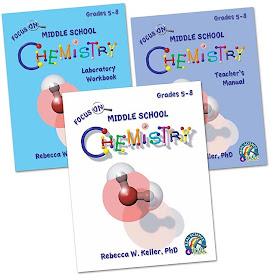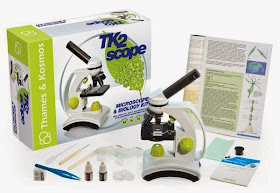
 |
| Level 1 Kit for Real Science 4 Kids |
We just finished with the Chemistry unit and so far it this curriculum working for us. The text is very simple, but goes into good detail at the same time. The hands on experiment with every chapter is great. The textbook, laboratory workbook, and teacher's manual are all nicely laid out and easy to follow.
Here's a little summary of our experience.
Chapter 1: Matter
This chapter introduces atoms and the periodic table. I supplemented here with Teacher Book Bag's Periodic Table of Elements Card Kit. Printed, laminated, and cut out the kids could handle all of the elements of the periodic table, sort them into types, match symbols with names, and even re-create the periodic table on the pocket chart (at least a good chunk of it before running out of room!)
There is a big selection of interactive on-line periodic tables for the kids to explore as well:
Chapter 2: Molecules
This chapter was lots of fun because we got to make molecules out of marshmallows!
 |
| Start with some carbon, oxygen, and nitrogen. |
 |
| Building molecules |
 |
| Even little sister joined in the fun! |
Chapter 3: Chemical Reactions
Who doesn't love a good chemical reaction experiment? Several different chemical reactions are discussed: combination reaction, decomposition reaction, displacement reaction, exchange reaction, and spontaneous.
Chapter 4: Acids, Bases, and pH
The experiment for this chapter was to make an acid-base indicator. The kids really had fun with this one, cutting up and boiling the cabbage and making the pH paper.
 |
| Making the pH paper with the purple cabbage water |
 |
| testing acids and bases with the homemade pH strips |
Chapter 5: Acid-Base Neutralization
In this experiment we got to use our cabbage water again to plot an acid-base titration. It was exciting to watch the solution turn from an acid into a base.
Chapter 6: Mixtures
We learned about two types of mixtures: heterogeneous and homogeneous. In the experiment we got to see first hand how soap helps dissolve oil in water.
Chapter 7: Separating Mixtures
This was one of my favorite experiments; using paper chromatography to separate individual colors in various inks.
Chapter 8: Energy Molecules
The kids read about a lot of the same things I recently learned in a college level nutrition class about nutrients, carbohydrates, monosaccharides, disaccharides, polysaccharides, starch, cellulose, amylose and amylopectin.
For the experiment we used tincture of iodine (in the kit we purchased) to test a variety of foods for starch content.
I created vocabulary flash cards for Chapters 8, 9, & 10. I printed them on card stock (they are already formatted to print on business cards, Avery 5371, if you don't want to have to cut them up yourself). I would put the words in the kids' workboxes with the definitions in the pocket chart and they would go match the words with the definition (or the other way around). Together we would check the pocket chart to see if they got them correct. Click here to link to a free pdf file of the vocabulary cards: Chemistry Vocabulary
I created vocabulary flash cards for Chapters 8, 9, & 10. I printed them on card stock (they are already formatted to print on business cards, Avery 5371, if you don't want to have to cut them up yourself). I would put the words in the kids' workboxes with the definitions in the pocket chart and they would go match the words with the definition (or the other way around). Together we would check the pocket chart to see if they got them correct. Click here to link to a free pdf file of the vocabulary cards: Chemistry Vocabulary
 |
| page 1 of the vocabulary cards |
Chapter 9: Polymers
After reading about polymers the experiment was to observe a change in properties as two polymers are added together. The kids were very excited to discover the fun, gooey glue that you get when you mix together white glue and laundry starch!
 |
| Little sister had lots of fun playing with the goo after the experiment was over! |
Chapter 10: Biological Polymers: Proteins and DNA
The final chapter is on DNA and in addition to the experiment in the text, we are going to extend the unit for a couple of weeks with some supplemental hands-on kits:
 |
| A DNA model from the Science Wiz kit. |


























































